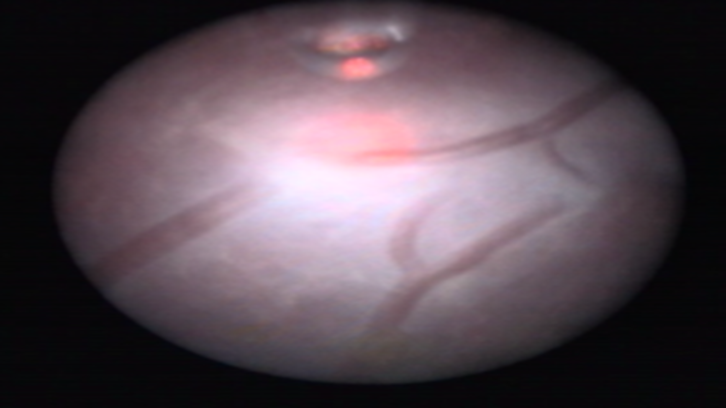Risk factors and techniques in preventing prematurity in pregnancies treated with fetal surgery

Preterm delivery can occur either due to the risks of pregnancy itself, or due to the need to perform some type of fetal surgery. There is an 8% to 12% chance of a baby being born prematurely in developed countries. A risk which increases from 5 to 6 times when it comes to multiple gestations. In this article, researchers from the Vall d'Hebron University Hospital review some of the risk factors, and evaluate a series of prevention techniques by comparing the risks involved in each one. The conclusions are based on their own experience as professionals, which has been published in scientific journals of impact.
Fetal surgery consists of the application of surgical techniques, generally minimally invasive surgery (fetoscopy), on the fetus in the prenatal stage. Fetoscopy has made it possible to expand the therapeutic options for numerous congenital anomalies, not without an increase in fetal morbidity and mortality, particularly related to prematurity. Laser coagulation of placental anastomoses is currently the most widely used fetoscopic technique. It is the treatment for twin-twin transfusion syndrome. There are other fetoscopic techniques, such as fetoscopic tracheal occlusion for the treatment of congenital diaphragmatic hernia; intrauterine repair of neural tube defects such as myelomeningocele; ultrasound-guided aortic valvuloplasty for the treatment of hypoplastic left heart syndrome; percutaneous thoracoamniotic shunting for pleural effusion, or intrauterine transfusion in cases of fetal anemia.
Prematurity is the leading cause of neonatal morbidity and mortality in the world. It occurs in 8-12% of all pregnancies in developed countries, and the risk is 5-6 times higher in multiple gestations than in singletons. It accounts for 70% of neonatal deaths and approximately 50% of long-term neurodevelopmental alterations, and these complications are inversely related to gestational age at the time of delivery.
Fetal surgery is a risk factor for preterm delivery. The type of anesthesia, the uterine scar, the manipulation of the uterus itself or the size of the trocars are risk factors for prematurity. Likewise, risk factors related to pregnancy, such as the history of a previous preterm delivery or shortening of the cervical length are also risk factors for a preterm delivery.
Prevention strategies for preterm birth that are applied for singletons and twins have also been tested for fetal surgery, with conflicting results. Some studies support the use of cerclage and / or cervical pessary in cases of fetal surgery with shortened cervical length, while others find no differences. Cervical cerclage is an invasive procedure that requires anesthesia, while cervical pessary is a non-invasive, easy-to-place tool that does not require anesthesia to manipulate.
Experience supports the use of the pessary in single and multiple pregnancies with minimal adverse effects, therefore, it should be considered as a useful and safe treatment also in cases of fetal surgery.
Silvia Arévalo, Maria Helena Tur-Torres, Carlota Rodó, Manel Mendoza, Pablo García-Manau, Nerea Maiz, Elena Carreras,
Maternal-Fetal Medicine Research Group, Department of Obstetrics
Vall d’Hebron Hospital Universitari
Universitat Autònoma de Barcelona.
References
Carreras E, Arévalo S, Bello-Muñoz JC, Goya M, Rodó C, Sanchez-Duran MA, Peiro JL, Cabero L. Arabin cervical pessary to prevent preterm birth in severe twin-to-twin transfusion syndrome treated by laser surgery; Prenat Diagn. 2012, 32(12):1181-5. doi: 10.1002/pd.3982. Epub 2012 Oct 11.
Dobrescu O, Cannie MM, Cordier AG, Rodó C, Fabietti I, Benachi A, Carreras E, Persico N, Hurtado I, Gucciardo L, Jani JC. Prophylactic use of the Arabin cervical pessary in fetuses with severe congenital diaphragmatic hernia treated by fetoscopic endoluminal tracheal occlusion (FETO): preliminary experience. Prenat Diagn. 2016; 36(1):81-7. doi: 10.1002/pd.4716. Epub 2015 Dec 1.
Rodó C, Arévalo S, Lewi L, Couck I, Hollwitz B, Hecher K, Carreras E. Arabin cervical pessary for prevention of preterm birth in cases of twin-to-twin transfusion syndrome treated by fetoscopic LASER coagulation: the PECEP LASER randomised controlled trial. BMC Pregnancy Childbirth. 2017 Aug 1; 17(1):256. doi: 10.1186/s12884-017-1435-0.


